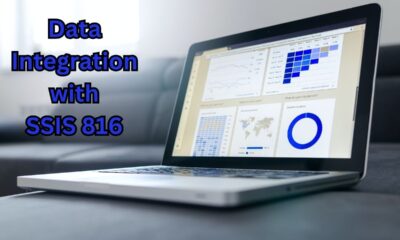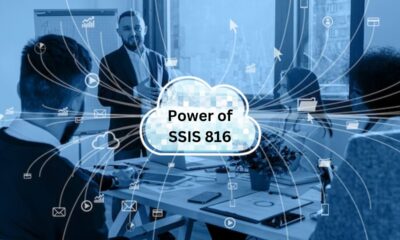Digital Marketing
Mastering SSIS 816: Everything You Need to Know
Published
5 months agoon
By
Saad
Welcome to the world of SSIS 816, where data integration and transformation reach new heights! If you’re looking to streamline your ETL processes and elevate your data management game, then you’ve come to the right place. In this blog post, we’ll delve into everything you need to know about mastering SSIS 816 – from its benefits and key features to tips for overcoming common challenges. Get ready to embark on a journey towards becoming an expert in SSIS 816!
Benefits of using SSIS 816
Are you looking to streamline your data integration processes? SSIS 816 is here to help! One of the key benefits of using SSIS 816 is its advanced functionality that allows for efficient extraction, transformation, and loading of data. This powerful tool empowers users to handle complex ETL tasks with ease.
By utilizing SSIS 816, you can significantly reduce manual intervention and automate repetitive tasks, saving time and effort in the long run. The robust features offered by SSIS 816 enhance performance and scalability, making it an ideal choice for businesses dealing with large volumes of data.
Moreover, SSIS 816 provides a user-friendly interface that simplifies the development process. Its intuitive design enables users to create sophisticated data workflows without extensive coding knowledge. Leveraging SSIS 816 can boost productivity and improve decision-making through quick access to accurate information.
Understanding the ETL process
Are you ready to dive into the fascinating world of ETL (Extract, Transform, Load) process in SSIS 816? Let’s unravel the magic behind how data is extracted from various sources, transformed into a suitable format, and loaded into a destination.
The first step in the ETL process involves extracting data from different systems like databases, files, or applications. This extraction phase sets the foundation for what comes next: transformation.
Once the data is extracted, it undergoes transformations to clean and restructure it according to business requirements. This crucial step ensures that the data is accurate and consistent before being loaded into the target system.
The transformed data is loaded into a designated destination such as a database or a data warehouse. The success of this final loading stage determines how efficiently insights can be derived from the processed information.
Understanding these fundamental steps in ETL lays down a solid groundwork for mastering SSIS 816 and harnessing its full potential.
Key Features and Components of SSIS 816
SSIS 816 is equipped with a range of key features and components that make it a powerful tool for data integration. One standout feature is its robust connectivity options, allowing users to easily extract data from various sources such as databases, cloud services, and flat files.
Another essential component of SSIS 816 is its transformation capabilities. With built-in transformations like sorting, aggregating, and merging data, users can manipulate data efficiently during the ETL process.
The package deployment model in SSIS 816 simplifies the management of integration projects by organizing workflows into packages that can be deployed and executed with ease.
Error handling mechanisms within SSIS 816 enable users to identify and address issues during data processing effectively. By setting up error outputs and redirecting erroneous rows, users can ensure the integrity of their data pipelines.
Mastering the key features and components of SSIS 816 will empower users to streamline their ETL processes and optimize data integration workflows.
How to Get Started with SSIS 816
Are you ready to dive into the world of SSIS 816 and harness its power for your data integration needs? Getting started with SSIS 816 is an exciting journey that can transform the way you handle ETL processes.
To begin, familiarize yourself with the user-friendly interface of SSIS 816. Take some time to explore its key features and components such as Control Flow, Data Flow, and Connection Managers.
Next, create a new project in Visual Studio and add a new Integration Services Project. This will serve as your workspace where you can design packages to extract, transform, and load data efficiently.
As you start building your first package, remember to leverage the vast array of tools and tasks available in SSIS 816. From simple data transformations to complex workflows, there’s no limit to what you can accomplish.
Don’t be afraid to experiment and test different scenarios – this hands-on experience will help solidify your understanding of SSIS 816 and propel you towards mastery.
Tips for Mastering SSIS 816
When diving into mastering SSIS 816, it’s essential to start with a solid foundation. Familiarize yourself with the key concepts and components of SSIS through online tutorials or training courses.
Practice makes perfect when it comes to honing your skills in SSIS 816. Experiment with different scenarios and datasets to gain hands-on experience.
Stay updated on the latest trends and updates in the world of data integration. Join forums, attend webinars, and engage with other professionals in the field to expand your knowledge.
Don’t be afraid to seek help when you encounter challenges. Utilize resources such as Microsoft documentation, online forums, or even reach out to experienced colleagues for advice.
Continuous learning is key to mastering SSIS 816. Stay curious and open-minded about exploring new features and functionalities that can enhance your ETL processes.
Remember that mastery takes time and patience. Celebrate small victories along the way as you progress towards becoming an expert in SSIS 816!
Common Challenges and Solutions
Encountering challenges while working with SSIS 816 is inevitable, but understanding how to tackle them head-on can make all the difference. One common issue users face is dealing with data quality issues during the ETL process. This can lead to inaccuracies in the output and affect decision-making processes downstream.
Another challenge that often arises is performance tuning. As data volumes increase, optimizing package execution becomes crucial for maintaining efficient operations. Fine-tuning settings such as buffer sizes and parallelism can significantly impact processing speeds.
Furthermore, integration errors between different systems or databases can pose a significant hurdle. Ensuring proper connectivity and data mapping is essential to prevent data loss or corruption during transfers.
To address these challenges, staying updated on best practices, actively participating in online communities for advice and solutions, and continuously refining your skills through practice are key strategies for mastering SSIS 816 effectively.
Real-World Applications of SSIS 816
Real-World Applications of SSIS 816
SSIS 816 is not just a tool for data integration; it’s a game-changer in the real-world. Businesses across various industries leverage SSIS 816 to streamline their ETL processes, automate workflows, and enhance data quality.
In the retail sector, SSIS 816 can be used to consolidate sales data from multiple sources, enabling companies to make informed decisions based on accurate insights. In healthcare, it helps in combining patient records from different systems for a comprehensive view of medical history.
Moreover, in finance, SSIS 816 plays a crucial role in reconciling transactions and generating financial reports efficiently. The versatility of this tool extends to marketing too; marketers use it to merge customer data from various platforms for targeted campaigns.
In essence, the real-world applications of SSIS 816 are vast and impactful across diverse industries. Its ability to handle complex data transformations with ease makes it an invaluable asset for organizations striving for efficiency and accuracy in their operations.
Conclusion: Becoming an Expert in SSIS 816
Mastering SSIS 816 is a valuable skill that can open up a world of opportunities in the realm of data integration and ETL processes. By understanding the benefits, key features, and components of SSIS 816, you are well on your way to becoming an expert in this powerful tool.
To truly excel in SSIS 816, continuous learning and practice are essential. Stay updated with the latest trends and developments in data integration, experiment with different scenarios using SSIS 816, and don’t be afraid to push the boundaries of what you can achieve with this tool.
Remember, mastering SSIS 816 is not just about technical proficiency; it’s also about problem-solving skills and creativity in designing efficient ETL workflows. Embrace challenges as opportunities for growth, seek out solutions through online communities or forums when needed, and always strive to improve your skills.
With dedication and perseverance, anyone can become an expert in SSIS 816. So keep exploring, keep learning, and keep honing your abilities with this powerful tool. The journey to mastery may have its ups and downs but staying committed will undoubtedly lead you to success in harnessing the full potential of SSIS 816.
Hi, I am Saad Qureshi and I am working since 2017 in this field with 5 years of experience in SEO and Guest posting. My range of services includes Article Posting on Authority Sites.

Digital Marketing
Harnessing the Power of Link Building in the Ever-Evolving Digital Landscape
Published
4 months agoon
March 12, 2024By
Saad
Introduction to Link Building
In the age of information abundance and the omnipresence of digital media, the significance of developing a robust online presence is unparalleled. The effective method known as link building is at the core of enhancing digital visibility. While the concept may seem straightforward—acquiring hyperlinks from external websites to your own—the mechanics and strategies behind it are varied and complex.
Link building is more than just building links; it’s a calculated move to increase a website’s prominence and authority in search engine results pages. Historically, it played a more straightforward role, but link building has morphed into an intricate dance that requires mastery and finesse with the constant evolution of search algorithms. The nuanced interplay between a website’s content, the quality of backlinks, and the search engines’ evolving criteria demands a deep understanding of SEO—and its link-building subset—to reap the desired organic growth and visibility. When executed skillfully by link building experts, it can surge a website’s search engine rankings, amplifying its reach to potential customers and industry audiences.
Exploring Different Types of Links
Link classification is an essential aspect of crafting a link-building strategy. SEOs must differentiate between two fundamental types: ‘dofollow’ and ‘nofollow’ links. Dofollow links are like virtual endorsements that signal search engines to pass on equity, whereas nofollow links, though once discounted, are now recognized for their role in fostering a natural link ecosystem. Search engines acknowledge that a blend of both types mirrors organic linking behavior, and thus, nofollow links garnish the link portfolio with an essence of authenticity.
An SEO strategy needing internal linking overlooks a vital aspect of site optimization. Internal links bind the site’s content together, facilitating a smooth user journey and spreading the influence of page authority throughout the domain. Conversely, when sourced from authoritative and relatable domains, external links act as beacons of trust and expertise, compelling search algorithms to cast a favorable gaze upon your site. Striking the optimal balance between internal and external linking practices is not just recommended; it’s necessary for a successful SEO blueprint.
The Anatomy of a Powerful Link Profile
A commanding link profile is distinguished by its diversity—a montage of backlinks from various high-quality domains indicating a broad spectrum of endorsements. A diverse profile signals to search engines that your content is valuable and endorsed across a multifaceted web. This reinforces your domain’s position as a hub of quality information and thought leadership. The subtleties in creating such a profile lie in astutely associating with domains that resonate with your content’s theme, thus ensuring relevance alongside diversity.
Another critical aspect of a robust link profile is the credibility of domains that link back to your site. High-authority sources can exponentially augment the SEO benefits, making each inbound link an influential contributor to your site’s search ranking ascent. This is where the strategic selection of anchor text comes into play. Varying your anchor text while keeping it contextually relevant avoids the pitfalls of over-optimization and enhances the organic feel of your link profile.
Metrics That Matter in Link Building
To ensure the efficacy of your link-building efforts, tracking their impact through various SEO metrics is imperative. Domain Authority (DA) and Page Authority (PA) gauge the likelihood of a domain or page ranking in search engine result pages (SERPs). However, it is essential to note that these metrics are not direct indicators of Google’s ranking algorithms but serve as useful comparative tools within SEO. They enable webmasters to evaluate potential linking partners and prioritize links that could wield the most significant influence.
Content as the Cornerstone of Link Acquisition
The adage ‘content is king’ rings particularly true in the context of link building. Stellar content exerts a gravitational pull, enticing other websites to link to it voluntarily—a process defined as ‘natural link acquisition.’ When your site becomes a repository of insightful, informative, and engaging content, it inevitably becomes a nodal point in the web for your industry or niche, organically accumulating links without overt solicitation.
The force of high-quality content is magnified when it is shared beyond the bounds of your site. Guest blogging embodies this principle, providing industry platforms with valuable insights while leaving a breadcrumb trail back to your domain. Moreover, content is not limited to text. Visually appealing infographics and captivating videos can become viral. With their shareability factor, they attract backlinks at an even greater magnitude.
White Hat vs Black Hat Link Building Techniques
SEO practices are frequently bifurcated into ‘white hat’ and ‘black hat’ techniques. The former encompasses strategies that align with search engine guidelines, focusing on creating a user-centric experience. White hat methods, such as creating persuasive content and engaging with the community, are built to withstand the test of time, thereby providing enduring SEO advantages. On the contrary, black hat techniques, which range from link farms to keyword stuffing, may yield quick yet volatile results that can lead to penalization—a risk no reputable site should entertain.
As Google’s search algorithms evolve with an increasing focus on user experience, the distinction between permissible and illicit techniques becomes all the more critical.
Utilizing Social Media as a Link Building Tool
The symbiosis between social media and SEO may take time, but a discerning marketer understands the depth of their interconnection. Social media’s vast landscape serves as fertile ground for link cultivation, thanks to the participatory nature of its communities. Active engagement on these platforms—not just in posting content but also in dialogues—bolsters your online profile and can lead to organic sharing and backlinking of your content.
Digital Marketing
Iversær: Revolutionizing Data Analysis
Published
5 months agoon
March 1, 2024By
Saad
Iversær is a cutting-edge data analysis platform that is revolutionizing the way organizations extract insights from their data. With its advanced algorithms and user-friendly interface, Iversær makes it easy for businesses to analyze large datasets quickly and accurately.
History and Background
Iversær was founded in 2010 by a team of data scientists and engineers with a passion for simplifying complex data analysis processes. Since its inception, Iversær has grown to become a leading player in the data analytics market, serving clients across a wide range of industries.
Features of Iversær
One of the key features of Iversær is its ability to handle large volumes of data with ease. Whether you’re dealing with terabytes of data or just a few gigabytes, Iversær can analyze it quickly and accurately, thanks to its advanced algorithms.
Another standout feature of Iversær is its user-friendly interface. Unlike other data analysis tools that require extensive training to use, Iversær is designed to be intuitive and easy to navigate, making it accessible to users of all skill levels.
Benefits of Using Iversær
The benefits of using Iversær are manifold. Firstly, Iversær can help businesses make better-informed decisions by providing them with valuable insights into their data. Whether you’re looking to optimize your marketing strategy or improve your operational efficiency, Iversær can help you achieve your goals.
Secondly, Iversær can save businesses time and money by streamlining the data analysis process. With Iversær, you can analyze large datasets in a fraction of the time it would take using traditional methods, allowing you to focus on other important tasks.
How Iversær Works
Iversær works by using a combination of advanced algorithms and machine learning techniques to analyze data. When you upload a dataset to Iversær, the platform automatically processes it and generates insights based on the data. These insights are presented in an easy-to-understand format, making it easy for you to interpret the results.
Industries that Benefit from Iversær
Iversær is used by a wide range of industries, including finance, healthcare, retail, and manufacturing. In the finance industry, Iversær is used to detect fraudulent activity and identify investment opportunities. In healthcare, Iversær is used to analyze patient data and improve treatment outcomes. In retail, Iversær is used to optimize pricing strategies and improve customer satisfaction. In manufacturing, Iversær is used to improve production efficiency and reduce waste.
Case Studies of Successful Implementation
Many businesses have already seen success with Iversær. For example, a leading retailer used Iversær to analyze customer data and identify new market opportunities, leading to a significant increase in sales. Similarly, a healthcare provider used Iversær to analyze patient data and improve treatment outcomes, leading to a reduction in patient readmissions.
Future Prospects of Iversær
The future looks bright for Iversær, with the company poised to continue its growth and expansion. With the increasing demand for data analysis solutions, Iversær is well-positioned to capitalize on this trend and cement its position as a market leader in the data analytics space.
Challenges and Limitations
While Iversær has many benefits, it also has some challenges and limitations. For example, the platform may not be suitable for very complex data analysis tasks that require specialized knowledge. Additionally, some users may find the pricing of Iversær to be prohibitive, especially for small businesses.
Comparison with Similar Solutions
Compared to similar solutions, Iversær stands out for its advanced algorithms, user-friendly interface, and ability to handle large volumes of data. While there are other data analysis tools on the market, few can match the capabilities of Iversær.
Conclusion
In conclusion, Iversær is a game-changer in the world of data analysis. With its advanced algorithms, user-friendly interface, and ability to handle large volumes of data, Iversær is helping businesses across industries make better-informed decisions and achieve their goals. As the demand for data analysis solutions continues to grow, Iversær is well-positioned to lead the way.
FAQs
- What industries can benefit from using Iversær?
- How does Iversær compare to other data analysis tools on the market?
- Can Iversær handle large volumes of data?
- How user-friendly is the interface of Iversær?
- What are some of the key features of Iversær?
Digital Marketing
Benefits Of Digital News Alerts
Published
5 months agoon
February 28, 2024By
Saad
In today’s fast-paced world, staying informed about the latest news and developments is crucial. Digital news alerts have become increasingly popular as they provide a convenient way to stay updated on current events. Whether you’re interested in global news, industry updates, or local happenings, digital news alerts can deliver the information you need directly to your inbox or smartphone.
Importance of Digital News Alerts
Digital news alerts offer several benefits over traditional news sources. They provide real-time updates, ensuring that you’re always informed about the latest developments. Additionally, digital news alerts are customizable, allowing you to receive updates on specific topics or keywords that are of interest to you. This level of customization ensures that you receive relevant information that is tailored to your needs.
How Digital News Alerts Work
Digital news alerts work by using advanced algorithms to scan the internet for news articles and updates that match your specified criteria. These criteria can include keywords, topics, or specific websites. Once a relevant article is found, the alert system sends you a notification via email, mobile app, or social media.
Types of Digital News Alerts
There are several types of digital news alerts, each offering unique benefits. Email alerts are the most common and deliver news updates directly to your inbox. Mobile app alerts provide notifications to your smartphone, ensuring that you’re always informed, even when you’re on the go. Social media alerts deliver news updates directly to your social media feeds, allowing you to stay updated while browsing your favorite platforms.
Benefits of Using Digital News Alerts
One of the key benefits of using digital news alerts is convenience. Instead of having to manually search for news updates, digital news alerts deliver relevant information directly to you. This saves time and ensures that you never miss important news. Additionally, digital news alerts can help you stay informed about niche topics or industries that may not receive widespread coverage in traditional news sources.
How to Set Up Digital News Alerts
Setting up digital news alerts is easy and can be done in a few simple steps. Most news websites and social media platforms offer the option to set up alerts based on your preferences. Simply navigate to the settings or preferences section of the website or app, and look for the option to set up alerts. From there, you can specify your criteria, such as keywords or topics, and choose how you’d like to receive alerts.
Best Practices for Using Digital News Alerts
To get the most out of digital news alerts, it’s important to use them strategically. Here are some best practices to keep in mind:
- Customize your alerts to receive updates on topics that are relevant to you.
- Limit the number of alerts you receive to avoid information overload.
- Use alerts from multiple sources to ensure that you’re getting a well-rounded view of the news.
- Regularly review and update your alert settings to ensure that they reflect your current interests and priorities.
Conclusion
Digital news alerts offer a convenient and efficient way to stay informed about the latest news and developments. By customizing your alerts and following best practices, you can ensure that you’re always up-to-date on the topics that matter most to you.
FAQs
- What are digital news alerts? Digital news alerts are notifications that deliver news updates directly to your inbox, smartphone, or social media feed.
- How do digital news alerts work? Digital news alerts use advanced algorithms to scan the internet for news articles and updates that match your specified criteria. Once a relevant article is found, the alert system sends you a notification.
- What are the benefits of using digital news alerts? Digital news alerts offer several benefits, including convenience, customization, and the ability to stay informed about niche topics or industries.
- How do I set up digital news alerts? Setting up digital news alerts is easy and can be done through the settings or preferences section of most news websites and social media platforms.
- What are some best practices for using digital news alerts? Some best practices for using digital news alerts include customizing your alerts, limiting the number of alerts you receive, and regularly reviewing and updating your alert settings.
Digital Marketing
Get To Know Rzinho: A Rising Star In Online Community
Published
5 months agoon
February 27, 2024By
Saad
Welcome to the world of Rzinho, a rising star in the online community scene! If you haven’t yet heard of him, get ready to be impressed. Rzinho has taken his passion and turned it into a successful career, all while building a supportive and engaged community around him. Join us on this journey as we delve into the story of how Rzinho went from pursuing a hobby to becoming an influential figure with a growing online presence.
The Journey to Becoming a Rising Star: From Hobby to Career
Have you ever wondered what it takes to turn a simple hobby into a successful career? Well, Rzinho’s journey is one for the books. What started as a passion project soon evolved into something much more significant. With dedication and hard work, Rzinho transformed his love for creating content into a sustainable source of income.
It wasn’t always smooth sailing though. Like many aspiring creators, he faced challenges and setbacks along the way. But instead of giving up, Rzinho persevered and continued honing his craft. Through trial and error, he learned valuable lessons that shaped his path to success.
Over time, Rzinho’s commitment paid off as he gained recognition within the online community. His unique style and engaging content captivated audiences worldwide, propelling him to rising star status in the digital realm.
From humble beginnings to carving out a niche for himself in the competitive online landscape, Rzinho’s journey serves as an inspiration to all those dreaming of turning their passion into a career.
Building an Engaged and Supportive Community
Building an engaged and supportive community is no easy feat, but for Rzinho, it has been a journey filled with dedication and passion. By fostering a welcoming environment where members feel valued and heard, Rzinho has successfully cultivated a space where individuals can connect and support each other.
Through consistent interaction and genuine care for his followers, Rzinho has created a sense of belonging that keeps the community thriving. Whether through live streams, social media engagement, or special events, he goes above and beyond to ensure that every member feels included.
By encouraging open communication and positive interactions among members, Rzinho has fostered a culture of respect and collaboration. This not only strengthens bonds within the community but also attracts new like-minded individuals who are eager to be part of something special.
In essence, building an engaged and supportive community takes time, effort, and authenticity – qualities that Rzinho embodies wholeheartedly in his online endeavors.
Balancing Personal Life with Online Success
Balancing personal life with online success can be a challenging juggling act. Rzinho, the rising star in the online community, knows this struggle all too well. With the demands of creating content, engaging with followers, and maintaining a consistent online presence, finding time for family and self-care can sometimes feel like an impossible task.
However, Rzinho has learned to prioritize and set boundaries to ensure that his personal life doesn’t take a backseat to his online endeavors. By scheduling dedicated time for loved ones and activities outside of the digital world, he strikes a healthy balance between work and play.
It’s essential for anyone navigating the waters of online success to remember that self-care is non-negotiable. Taking breaks, practicing mindfulness, and disconnecting from screens are crucial habits that contribute to overall well-being.
Rzinho sets a positive example by showing that achieving success in the virtual realm doesn’t have to come at the expense of one’s happiness or relationships. Finding harmony between personal life and professional aspirations is key to long-term fulfillment in both spheres.
The Impact of Rzinho’s Community on Others
Rzinho’s online community has had a profound impact on others, extending far beyond the virtual realm. Through his engaging content and positive energy, he has created a space where people feel welcomed and supported. Members of his community often express how they have found inspiration, motivation, and even lifelong friendships through their interactions.
The sense of belonging that Rzinho fosters within his community is truly remarkable. Many individuals have shared stories of personal growth and self-discovery thanks to the encouragement they receive from both Rzinho and fellow members. This supportive environment has empowered many to pursue their passions fearlessly and chase their dreams with confidence.
Moreover, the ripple effect of positivity generated by Rzinho’s community is undeniable. Countless individuals report feeling more optimistic, hopeful, and connected after becoming part of this uplifting digital family. The impact goes beyond just likes or comments; it’s about creating real change in people’s lives for the better.
In essence, Rzinho’s community serves as a shining example of how online platforms can be used to spread kindness, foster genuine connections, and make a meaningful difference in the world around us.
Advice for Aspiring Online Creators and Community Leaders
For aspiring online creators and community leaders, my advice is to stay authentic. Your audience can tell when you’re not being genuine, so always be true to yourself and your values. Consistency is key – keep creating and engaging with your community regularly. Don’t be afraid to experiment with different types of content or engagement strategies to see what resonates best with your audience.
Building a supportive community takes time, so be patient and persistent in nurturing those relationships. Remember that it’s okay to ask for help or collaborate with others in the online space. Networking can open up new opportunities and perspectives that can benefit both you and your community.
Stay updated on trends in the online world but don’t lose sight of what makes you unique. Find your niche and own it confidently. And most importantly, never underestimate the power of positivity – spread kindness and encouragement within your community, and watch it thrive organically.
Conclusion: The Future of Rzinho and His Community
As Rzinho continues to soar in the online world, his community stands as a shining example of what can be achieved through passion, dedication, and genuine connection. With unwavering support from his followers and a commitment to authenticity, Rzinho is undoubtedly on the path to even greater success.
The future looks bright for Rzinho and his community. As he navigates the ever-evolving digital landscape, one thing remains certain – his impact will continue to inspire others to pursue their dreams fearlessly. So keep an eye out for this rising star in the online realm – because with Rzinho at the helm, anything is possible.
Trending
-

 ENTERTAINMENT5 months ago
ENTERTAINMENT5 months agoHBO Max TV Sign In Guide
-

 FASHION7 months ago
FASHION7 months agoJourney of Sandra Orlow From Aspiring Model to Internet Sensation
-

 TRAVEL6 months ago
TRAVEL6 months agoUnveiling the Beauty: A Closer Look at myfavouriteplaces.org Blog
-

 NEWS7 months ago
NEWS7 months agoBench Craft Company Lawsuit: A Comprehensive Analysis
-

 BUSINESS7 months ago
BUSINESS7 months agoChina SEO Xiaoyan: Pioneering the Path in Chinese Digital Marketing
-

 FASHION5 months ago
FASHION5 months agoThe Rise of Jeansato: A Revolutionary Denim Trend
-

 ENTERTAINMENT5 months ago
ENTERTAINMENT5 months agoGeekzilla Podcast: Navigating the Geek Cosmos
-

 TECH7 months ago
TECH7 months agoExploring Fibahub – Your Ultimate Solution for Seamless Communication




